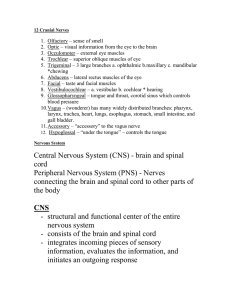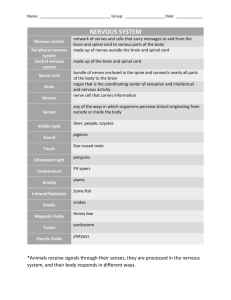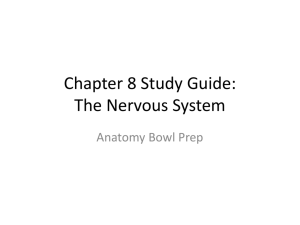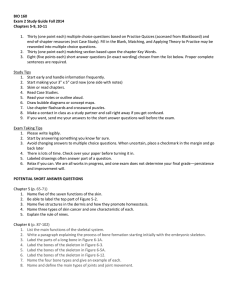The Musculoskeletal System &
advertisement
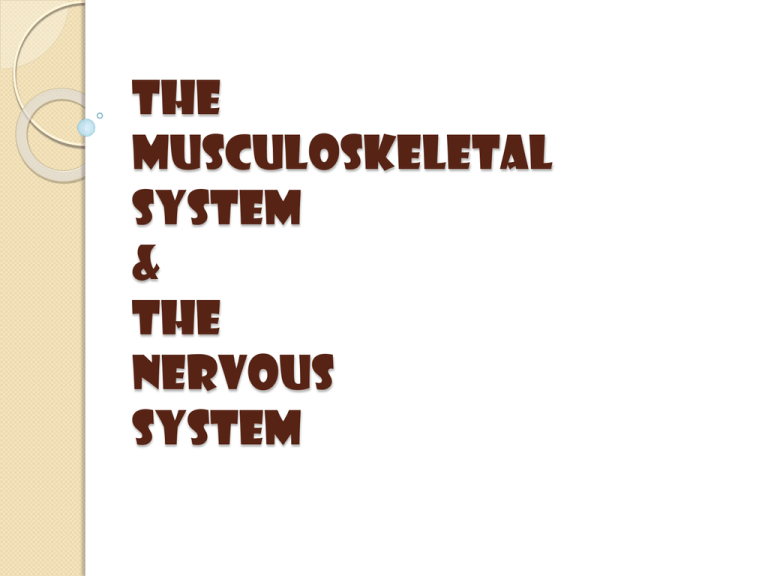
The Musculoskeletal System & The Nervous System Musculoskeletal System This system is made up of all the bones in your body and all the muscles that make them move. Skeleton Consists of 3 different types of connective tissue: Bones Ligaments Cartilage Bones Bone is hard and dense Made up of bone cells within a matrix of minerals (mainly Ca and P) and collagen fibres Canals inside the bones contain nerves and blood vessels Only a small percentage of bone is actually living Ligaments Tough and elastic Hold bones together at the joints Made of mostly long fibres of collagen Cartilage Dense tissue Found in the ear, nose, esophagus, the disks between our vertebrae and joints Made of special cells in a matrix of collagen fibres Provides a strong, flexible, lowfriction support for bones and other tissues Skeleton Functions Provides support and structure for our bodies and anchor points for muscles Protects our soft internal organs and brain Stores calcium and other minerals Some contain marrow which produces red and white blood cells Muscles Consists of 3 types of muscle tissue: Skeletal Muscle: voluntary; attached to bones by tendons, allowing body parts to move Smooth Muscle: involuntary; mainly in intestines Cardiac Muscle: only in heart Tendons Muscles and bones are connected by tendons Tendons are similar to ligaments, but are less elastic Musculoskeletal System problems Osteoporosis: A disease that can affect people of all ages, but is more common in older women Physical Stresses: Extreme movements can tear ligaments, tendons and muscle tissues Severe movements can fracture bones Osteoporosis Involves loss of bone tissue which makes bones brittle and weak Does not cause pain Tested for with a bone density test Linked with a loss of calcium in bones Nervous System This system is made up of the brain, spinal cord and peripheral nerves. It is the system that senses the environment and coordinates appropriate responses. Central Nervous System CNS Consists of the brain and spinal cord CNS The skull protects the brain and the spine guards the spinal cord Surrounded by cerebrospinal fluid which helps to cushion them from injury, transports chemicals and removes wastes that are produced in the brain. Peripheral Nervous system Consists of nerves that connect the body to the central nervous system PNS Consists of 3 groups of nerves: Nerves that control the voluntary muscles Nerves that carry information from the sensory organs Nerves that regulate involuntary functions such as breathing, heartbeat and digestion Nerve Tissue Found in the brain, spinal cord and nerves Nerve tissue is made up of special cells called neurons Nerves are bundles of neurons that are surrounded by connective tissue Neurons Neurons’ structure enables them to send information around the body by conducting electrical signals from one area of the body to another Injured neurons in the CNS do not easily regenerate Myelin Myelin sheath acts like the insulation on an electrical wire, preventing electrical impulses from passing to the wrong neuron. Nervous System Problems Multiple Sclerosis A disease caused by a malfunction of the immune system in which the myelin sheaths of neurons in the CNS are destroyed. Symptoms are muscle weakness, slurred speech and difficulty walking. Head Injuries A CT or MRI scan are suggested for someone that may have experienced physical trauma to the head or spinal cord.

